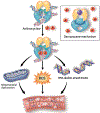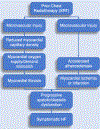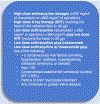Personalized Approach to Cancer Treatment-Related Cardiomyopathy
- PMID: 32125627
- PMCID: PMC7860625
- DOI: 10.1007/s11897-020-00453-3
Personalized Approach to Cancer Treatment-Related Cardiomyopathy
Abstract
Purpose of review: Cancer treatment-related cardiotoxicity (CTRC) represents a significant cause of morbidity and mortality worldwide. The purpose of our review is to summarize the epidemiology, natural history, and pathophysiology of cardiotoxicity-related to cancer treatment. We also summarize appropriate screening, surveillance, and management of CTRC. While cardiotoxicity is characteristically associated with anthracyclines, HER2-B antagonists, and radiation therapy (XRT), there is growing recognition of toxicity with immune checkpoint inhibitors (ICI), tyrosine kinase inhibitors, and proteasome inhibitors.
Recent findings: Patients at risk for cardiotoxicity should be screened based on available guidelines, generally with serial echocardiograms. The role of medical heart failure (HF) therapies is controversial in patients with asymptomatic left ventricular dysfunction but may be considered in some instances. Once symptomatic HF has developed, treatment should be in accordance with ACC/AHA guidelines. The goal in caring for patients receiving cancer treatment is to optimize cardiac function and prevent interruptions in potentially lifesaving cancer treatment.
Keywords: Cancer therapeutics–related cardiac dysfunction; Cardio-oncology; Cardiomyopathy; Chemotherapy; Heart failure; Immune checkpoint inhibitor.
Conflict of interest statement
Figures








References
-
- Reboux G. Cancer. https://www.who.int/news-room/fact-sheets/detail/cancer September 12, 2018. Accessed November 11, 2019.
-
- American Society of Clinical Oncology. The state of cancer care in America, 2015: a report by the American Society of Clinical Oncology. Journal of Oncology Practice. 2015;11(2):79–113. - PubMed
-
- Lefrak EA, Pitha J, Rosenheim S, Gottlieb JA. A clinicopathologic analysis of adriamycin cardiotoxicity. Cancer. 1973;32(2):302–14. - PubMed
-
-
• Chang H-M, Moudgil R, Scarabelli T, Okwuosa TM, Yeh ETH. Cardiovascular complications of cancer therapy: best practices in diagnosis, prevention, and management: part 1. Journal of the American College of Cardiology. 2017;70(20):2536–51. This paper discusses about the best practice guidelines for management of cancer-therapy mediated cardiomyopathy.
-
Publication types
MeSH terms
Substances
Grants and funding
LinkOut - more resources
Full Text Sources
Medical
Research Materials
Miscellaneous

